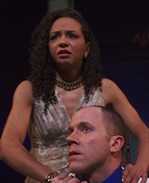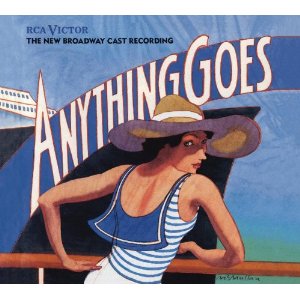SITE GUIDE
SEARCH
REVIEWS
REVIEW ARCHIVES
ADVERTISING AT CURTAINUP
FEATURES
NEWS
Etcetera and
Short Term Listings
LISTINGS
Broadway
Off-Broadway
NYC Restaurants
BOOKS and CDs
OTHER PLACES
Berkshires
London
California
New Jersey
DC
Philadelphia
Elsewhere
QUOTES
TKTS
PLAYWRIGHTS' ALBUMS
LETTERS TO EDITOR
FILM
LINKS
MISCELLANEOUS
Free Updates
Masthead
A CurtainUp Review
Richard III: Born With Teeth
|
"Now is the winter of our discontent/ Made glorious summer by this sun of York." — Richard of Gloucester
|

Richard (James Wallert) and Lady Anne (Carra Patterson
(Photo: Steven Boling) |
With the tag "Born With Teeth" this villainous Richard III is in modern dress with his charm at full-throttle. Though you might have seen more psychologically-probing takes on Richard, Director Ron Russell surely puts his pedal to the metal and allows you to take a fresh whiff of Richard’s ambition and experience the political world he inhabited.
Since a voucher for a signature “York Rose” cocktail comes with your ticket, get to the performance early to claim yours at the lobby bar before show-time. Once you have your drink in hand, you can either settle into your seat or mingle with the “potentates” on stage. No doubt this social-fest is the prelude to the political wheeling-dealing that will unfold.
The play starts out with cinematic fluidity, and shuttles between scenes in Shakespeare’s Richard III and Henry VI: Part III. The opener is from Richard III with King Edward IV (Godfrey L. Simmons) telling Rivers (Michael Kirby) and Hastings (Peter Jay Fernandez) to “seek not vengeance, but reconciliation.” You then get a flashback to Henry VI: Part III, where Queen Margaret (Lanna Joffrey) mockingly crowns York with a paper crown before stabbing him to death and ordering his beheading.
That beheading order is far and away one of the most dramatic moments in Shakespeare’s canon, and Margaret’s vengeful words still carry their sting: “Off with his head and set it on York gates; So York may overlook the town of York.” This retro-scene not-so-subtly reminds the audience that the York family had suffered a-plenty during the War of the Roses, and that their subsequent power-grab for the crown was, if not completely justified, at least put in the historical context of the blood-thirsty saga.
The flashback fades out, and Richard of Gloucester (James Wallert) arrives on the scene, beginning his famous soliloquy: “Now is the winter of our discontent . . . .” With his characteristic candor, lays out his grand design for seizing the crown. You might have heard this speech countless times, but framed by Mikiko Suzuki MacAdams’ alabaster-white set and Melissa Mizell & Cat Tate Starmer’s natural lighting, it gains a fresh immediacy here.
The last production of Richard III I saw on stage was at the Brooklyn Academy of Music, with Kevin Spacey stepping into the title role. While that one had stardust going for it, the Epic Theatre Ensembl iteration has more contemporary relevance thanks to the recent exhumation of Richard III. If timing is key, the timing of this show is ideal.
But the company is not coasting along on the media’s headlines. Though Russell sometimes overplays the cartoon-like aspect of the play (Written in or around 1592, this is an earlier play of the Bard’s), this is a solid production. It's also so much fun to watch that it would be quibbling to object to its light-handed direction or poetic license. However, some scenes would really have gained more dramatic power with a soberer approach. For instance, the scene where Clarence (Rhett Henckel) is drowned in a Malmsey-butt (purportedly Clarence’s favorite wine) can be emotionally gripping if done with utter sincerity. In this case it was the one time that the actors toppled over into jokey-ness, when they should have simply trusted Shakespeare’s language to work its own mysterious power.
All ten actors (Peter Jay Fernandez, Melissa Friedman, Devin E. Haqq, Rhett Henckel, Lanna Joffrey, Michael Kirby, James Joseph O’Neil, Carra Patterson, Godfrey L. Simmons, and James Wallert) strut their stuff, and considering this is Richard III, the strutting doesn’t seem forced but right in step with the politically-astute York family.
James Wallert, as Richard of Gloucester, plays his ambitious character with appropriate self-consciousness. Unlike most Richards of yesteryear, Wallert’s Richard doesn’t have a pronounced hunchback or a raised shoulder, though he does hold one hand across his torso like it was frozen in place. It’s only in a late scene, when he strips off his shirt and reveals a steely back brace, that his character’s infamous deformity (many scholars and medical experts suspect that the historical Richard III had some form of scoliosis) is visually glimpsed by the audience. While you may miss the sight of Richard looking like a larger-than-life spider on stage, Wallert subliminally reminds you that the real deformity of his character is in his mind and heart.
The performance I attended was followed by a post-show forum, moderated by Julian Zelizer, a Professor of History at Princeton University, and Jessica Blatt, a Professor of Political Science at Marymount Manhattan. Focusing on the topic “How Does New Information Impact Our Perceptions of History,” they discussed the necessity of assessing, and re-assessing, historical figures, over time. Not surprisingly, the late Richard Nixon was held up for discussion. Zelizer pointed out that Nixon, who resigned in the aftermath of the Watergate scandal, may well be seen in a different (and perhaps fairer) light in the future. Both professors agreed that it is easy to demonize historical figures like Richard III and Nixon, and much more difficult to place them in historical perspective.
|
Richard III: Born With Teeth by William Shakespeare Directed by Ron Russell Cast: Peter Jay Fernandez (Hastings), Melissa Friedman (Elizabeth), Devin E. Haqq (Catesby), Rhett Henckel (Clarence/Bishop), Lanna Joffrey (Margaret), Michael Kirby (Rivers/Mayor/Richmond), James Joseph O’Neil (Buckingham), Carra Patterson ( Lady Anne), Godfrey L. Simmons, Jr. (Edward IV/Stanley), James Wallert (Richard of Gloucester). Sets: Mikiko Suzuki MacAdams Costumes: Margaret E. Weedon Sound: Ron Russell Lighting: Melissa Mizell & Cat Tate Starmer Fight Direction: Unkle Dave’s Fight-House: Nic Grelli and Jesse Geguzis Movement: Will Pomerantz Stage Manager: Erin Maureen Koster Alice Griffin Jewel Box Theater at the Pershing Square Signature Center, 480 West 42 Street. Tickets: $25. Phone Ticket Central: 212/279-4200 or visit www.ticketcentral.com or for more information, visit www.epictheatreensemble.org/R3 From 4/16/13; opening 4/20/13; closing 5/04/13. Wednesdays, Thursdays, and Fridays @ 7:30pm; Saturdays @ 8pm; The show is dark on Thursday, May 2nd. Tuesday through Saturday @ 8pm. Running time: 2 hours: 25 minutes with 10-minute intermission Reviewed by Deirdre Donovan based on press performance of 4/17/13 |
| REVIEW FEEDBACK Highlight one of the responses below and click "copy" or"CTRL+C"
Paste the highlighted text into the subject line (CTRL+ V): Feel free to add detailed comments in the body of the email. . .also the names and emails of any friends to whom you'd like us to forward a copy of this review. Visit Curtainup's Blog Annex For a feed to reviews and features as they are posted add http://curtainupnewlinks.blogspot.com to your reader Curtainup at Facebook . . . Curtainup at Twitter Subscribe to our FREE email updates: E-mail: esommer@curtainup.comesommer@curtainup.com put SUBSCRIBE CURTAINUP EMAIL UPDATE in the subject line and your full name and email address in the body of the message. If you can spare a minute, tell us how you came to CurtainUp and from what part of the country. |

Slings & Arrows- view 1st episode free
 Anything Goes Cast Recording
Anything Goes Cast RecordingOur review of the show
 Book of Mormon -CD
Book of Mormon -CDOur review of the show

